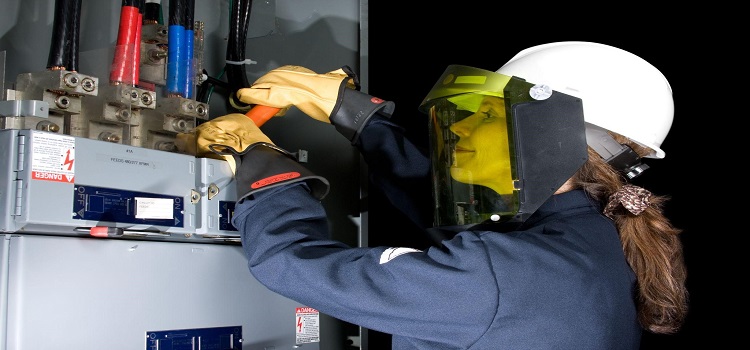
Source: FlashMovie/Shutterstock.com
Causes Of An Arc Flash
It’s no exaggeration to say that arc flashes are among the most feared and dangerous events in the entire electrical industry. These electrical discharges have extraordinarily violent effects that can easily cause serious injuries or death to a worker, especially if the worker isn’t wearing the correct arc-rated PPE.
If you work with electrical equipment, you’re probably at least aware of the existence of arc flashes and the need to guard against them. Businesses deploy a huge range of solutions, from specialty electrical enclosure boxes to arc-rated PPE, in mitigating arc flash hazards.
However, it’s important to understand how the phenomenon itself works. Ahead, we’ll discuss the fundamentals of understanding arc flashes and how to prevent them.
Causes of an Arc Flash
An arc flash happens when a fault condition causes an electrical current to jump off of its correct path and cross an air gap in search of a path to ground. When a high voltage current hits the air, the resistance of the air to the current creates a massive discharge of heat and light as the gas is converted into plasma. Energy from the vaporization of metal components may also contribute to the force of the arc flash.
Equipment types such as switchgear, motor control centers, and transformers are the most common sites of arc flashes. The extremely high voltage currents that many of these devices handle means that arc flashes are always a concern that has to be kept in mind.
Arc Flash and Arc Blast: The Effects of Arc Discharges
An arc flash is actually made of up two elements: the arc flash proper and the arc blast. It’s important to understand both of them and to know the safety measures that each requires.
Arc Flash
The arc flash itself is a huge, sudden discharge of heat and light that can reach up to 35,000ºF. This is the same force that’s harnessed in a controlled form for arc welding, so it’s easily hot enough to melt metal. That means that, for a worker, the injury potential from even a lower temperature arc flash is severe.
It’s also not unusual for arc flashes to start fires that can then spread throughout a facility. The high temperatures can easily create fires in flammable objects caught in the flash area, so facilities have to be carefully planned to avoid fires in the event of an arc flash.
Arc Blast
Arc blast, on the other hand, is a pressure wave that happens almost simultaneously with the arc flash. As the energy discharge vaporizes matter in its path, including air and metal conductors, the air displacement creates a shockwave.
It’s common for a large arc flash to produce a shockwave powerful enough to toss a worker across a room like a rag doll. Arc blasts also often contain showers of molten shrapnel from disintegrated parts, which can cause severe injuries or death on their own. Finally, the blast is often loud enough to cause severe and permanent hearing damage.

Source: M2020/Shutterstock.com
Risk Factors for Arc Flashes
An arc flash should never happen in a well-functioning system operated by trained personnel. When they do occur, the cause can usually be traced to one of the following:
- Insulation and other components in poor mechanical condition
- Dust and debris on components
- Human error, such as mishandled tools or accidental contact
- Lack of correct lockout tagout procedures
- Systems designed without the right arc flash mitigation technologies
Arc flashes are almost always preventable if your workplace is committed to identifying and preventing arc fault conditions. Let’s take a look next at how many businesses address these hazards.
Preventing and Mitigating Arc Flashes
Any business that uses equipment that could potentially cause an arc flash is responsible for implementing arc flash risk management. These are some of the key strategies that businesses use:
- Whenever possible, workers should use remote operation devices (sometimes called “chicken switches”) to test a device from a safe distance away. Even then, workers may still need to suit up in some level of PPE, and they should remain aware of the arc flash boundary.
- Re-familiarize yourself with the NFPA 70E electrical safety standard, including new revisions in the 2021 edition. It’s the consensus industry safety standard on electrical safety, which means that OSHA requires employers to follow it.
- Businesses should have a regular maintenance schedule to keep potentially hazardous equipment maintained well. Develop a checklist that includes common failure points such as frayed insulation or excessive dust. Set a preventive maintenance schedule to ensure that the system stays in excellent shape.
- Ensure that sensitive elements of your electrical system such as switchgear are protected by an electrical junction box with the correct rating. A NEMA- or IP-rated enclosure will help keep your equipment in good condition and protect it from environmental hazards.
- Remember that PPE and safety strategies need to account for both arc flash and arc blast. Make sure to calculate the incident energy of a potential arc flash and plan accordingly for the amount of protection that workers and facilities will need.

Source: Reggie Lavoie/Shutterstock.com
The more you know about arc flashes, the more effectively you’ll be able to address the risks that present themselves in environments with high voltage equipment. However, remember that knowledge and action together are what create results, so make the effort to stay in compliance with arc flash standards every day.











